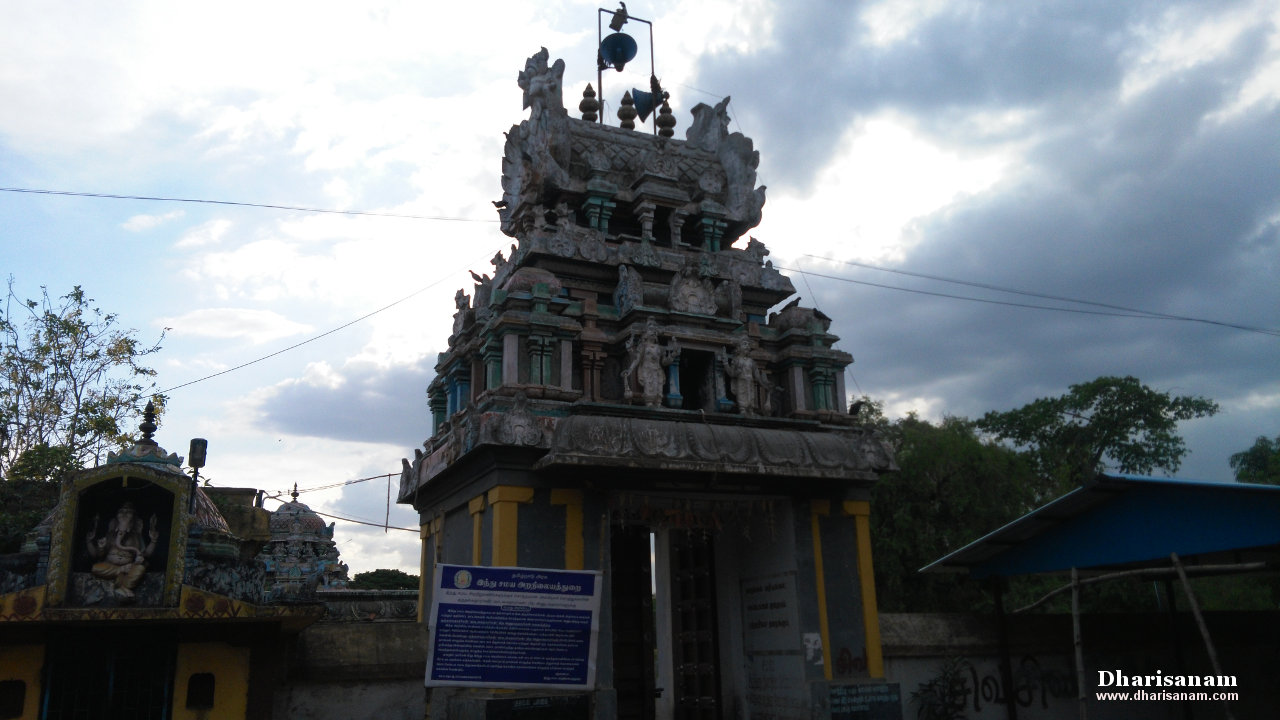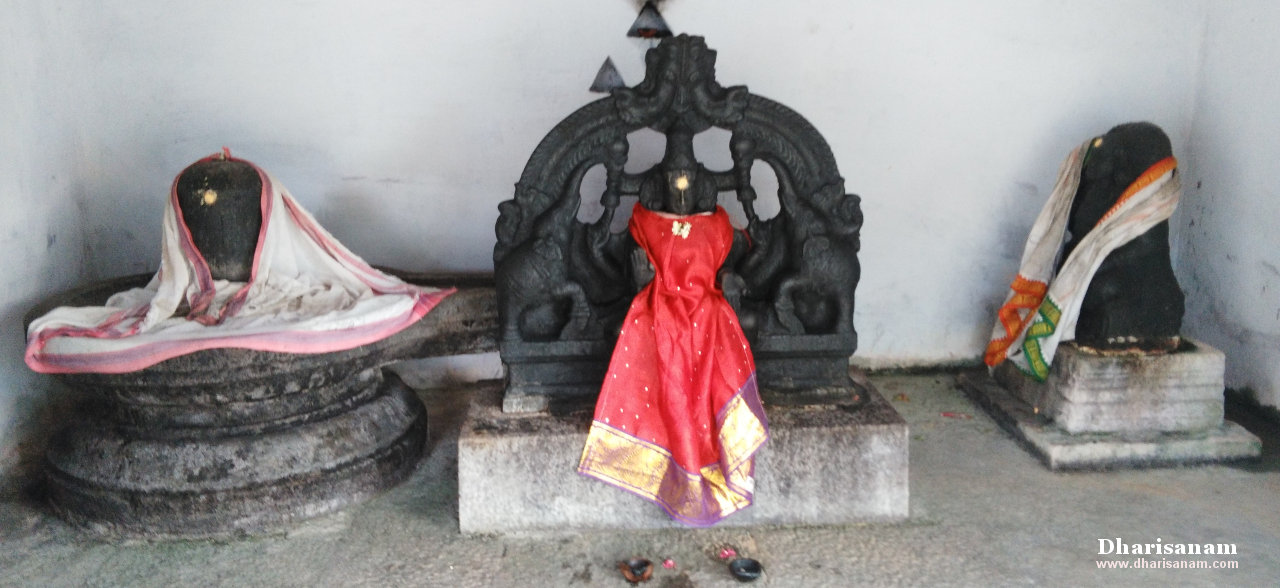Visited on: 29th June, 2018.
Location
Vanniyur (Anniyur) is situated at a distance of about 28 kms from Mayiladuthurai on the Mayiladuthurai to Thiruvarur route. Frist travel to Poonthottam (20 kms) and then travel about 8 kms to Vanniyur (via Thiruveezhimizhalai).
From Kumbakonam also, it is about 28 kms on the Kumbakonam to Karaikkal route (Via S. Pudur-20 kms). From S.Pudur, take diversion route and travel for about 5 kms to reach this temple.
Other Devara Paadal Petra Shiva Sthalams near this temple are – Thiruvizhimizhalai, Karuvili Kottitai (Karuveli), Thirumiyachur, Thirumiyachur Ilamkoil, Thilathaipathy, Thiruppampuram, Serukudi, Thiru Kottaram, Ambal Maakalam and Ambar Perunthirukkoil.
General Information
| Moolavar | Sri Agnipureeswarar, Sri Agneeswarar |
| Ambal | Sri Gauri Parvathy |
| Theertham (Holy water) | Agni Theertham |
| Sthala Vriksham (Sacred Tree) | Vanni tree |
| Pathigam (Hymn) rendered by | Saint Thirunavukarasar (Appar)-1 |
- This is one of the 276 Devara Paadal Petra Shiva Sthalams and 62nd Shiva Sthalam on the Southern bank of the river Cauveri in Chozha Nadu (Thenkarai).
- Lord Shiva in this temple is a Swayambumurthi (self-manifested).
- This east facing temple has a single corridor and its main tower (Rajagopuram) has 2-tiers.
- This temple has no flag post “Dwajasthambam”.
- The last consecration ceremony (Maha Kumbabishekam) took place on 21.08.2002.
History of the Temple
This ancient temple is situated on the northern banks of the river Arisilaru, a tributary of river Cauvery.
The historical name of this place is Vanniyur but now it is known as Anniyur.
This temple is under the administrative control of the Hindu Religious and Charitable Endowments Department of Government of Tamil Nadu (HR&CE).


Legend
It is believed that Goddess Parvathy came to this place before her marriage in order to perform penance. Pleased with her penance, Lord Shiva blessed her with his darshan and married her in Thiruveezhimizhalai (a nearby place).
According to legend, Agni participated in the yagna conducted by king Dakshan. In this yagna, Dakshan had intentionally not invited Lord Shiva. Lord Shiva was angered by this slight and instructed to Veerabadrar and Badrakalai to punish the participants who had attended it without his permission. In this process, Agni lost his hands and tongues and was also inflicted with some curses. As a result of these curses, Agni was unable to participate in any yagna. This resulted in the failure of monsoon and caused severe drought. Worried by this, he came to this place, installed a Shivalingam, created a pond and worshiped the lord with the leaves of Vanni tree. It is believed that Lord Shiva pardoned him, absolved him of his sins and restored his lost body parts.
Agni prayed to Lord Shiva that he should stay back here and bless the devotees who come here to get relief from “ushnam” ailment. Hence the lord here is praised as “Sri Agreenswarar” and this place gets the name “Vanni Oor” / “Agni Ooor”. This name has later changed to Vanniyur / Anniyur. (“Oor” means village in Tamil).
It is believed that Lord Brahma, Agni, Sage Agasthiyar, Sanathkumarar and Sanathanar have worshiped the lord here.
Deities in the temple
Other than the shrines of Lord Shiva and Goddess Parvathy, shrines and idols of Vinayakar, Balasubramaniyar, Shivalingams, Gajalakshmi, Chandikeswarar (2), Bairavar, Suryan, Chandran, Saneeswarar and Nalvar can be seen in the hall and in the corridor.
In the “koshtam” (place surrounding the sanctum sanctorum), idols of Dakshinamurthy, Lingothbavar, Brahma and Durgai can be seen.








Salient Features
In the outer corridor, there are some beautiful reliefs depicting the legends from Sthala Puranam. They are – Saint Appar, Agni, Goddess Gauri Parvathy, Shivalingam, Goddess Parvathy (in the form of a cow) worshiping the lord and Rishabaruder.
On either side of the entrance to the sanctum, there are small idols of “Dwarapalakas”.
Reliefs of some sages can also be seen in the corridor next to Goddess Durgai’s shrine.
This temple’s Sthala Viruksham, Vanni tree is believed to be more than 1600 years old.
This temple is considered to be significant for its three important attributes – Moorthy, Sthalam and Theertham - glory of Lord, sacredness of the land and the auspicious temple tank.
It is believed that Lord Suryan (Sun) worships Lord Shiva of this temple by directing his rays on the lingam every year for three days (18, 19 and 20) in the Tamil month of Aavani (Aug-Sept), and three days (18,19 and 20) in Panguni (Mar-Apr).
There are eight Shiva temples which are believed to have been worshiped by “Ashta Dik Palakars”. Vanniyur is one among them. Worshiping these lords is considered to be very auspicious. These temples are –
- Indra - Nagambadi,
- Agni – Vanniyur,
- Yama – Karuvili,
- Niruthi – Vayalur,
- Varunan – Sivanakaram,
- Vayu – Akalangan,
- Kubera – S.Pudur, and
- Esanan – Nallavur.

Greatness of this temple
As Goddess Parvathy worshiped Lord Shiva here and got married later, devotees pray to the goddess for removal of obstacles in their marriage proposals.
Devotees believe that taking a dip in this temple’s Agni Theertham and worshiping the lord will cure blood pressure and “ushnam” ailment.
Important Festivals
Some of the important festivals celebrated in this temple are –
Vinayakar Chaturthi in the Tamil month of Aavani (Aug-Sept),
Annabishekam in the Tamil month of Aippasi (Oct – Nov),
Thiru Karthikai in the Tamil month of Karthikai (Nov-Dec),
Thiruvadhirai in the Tamil month of Markazhi (Dec-Jan) and
Shivrathri in the Tamil month of Masi (Feb-Mar).
Pradosham is also observed regularly.
Temple Timings
From 08:00 AM to 12:00 noon and from 05:00 PM to 08:00 PM.
Temple Address
Sri Agnipureeswarar Temple,
Vanniyur (Anniyur) Post,
Kudavasal Taluk,
Thiruvarur District,
Tamil Nadu – 612 201.
This temple’s priest Sri N.Ganesa Gurukkal can be contacted at +91 – 435-2449578.





Pathigam (Hymn) with English transliteration and Tamil meaning.
Saint Thirunavukkarasar visited this temple and sang this Pathigam.
Devotees visiting this temple should make it a practice to recite this Pathigam.
Pathigam No.5.026.
காடு கொண்டரங் காக்கங்குல் வாய்க்கணம்
பாட மாநட மாடும் பரமனார்
வாட மானிறங் கொள்வர் மணங்கமழ்
மாட மாமதில் சூழ்வன்னி யூரரே.
“Kāṭu koṇṭaraṅ kākkaṅkul vāykkaṇam
pāṭa mānaṭa māṭum paramaṉār
vāṭa māṉiṟaṅ koḷvar maṇaṅkamazh
māṭa māmathil chūzhvaṉṉi yūrarē”.
மணம் கமழ்கின்ற மாமடங்களும், மாமதில்களும் சூழ்கின்ற வன்னியூரில் வீற்றிருக்கும் இறைவர். சுடுகாட்டினை அரங்காகக்கொண்டு, நள்ளிரவில் பூதகணங்கள் பாடப் பெருநடம் ஆடும் பரமர்; மான்போன்ற இப்பெண் வாட, இவளது பொன்னிறத்தைத் தாம் கொண்டு பசலை நிறம் தந்த இயல்புடையவர்.
செங்கண் நாகம் அரையது தீத்திரள்
அங்கை யேந்திநின் றார்எரி யாடுவர்
கங்கை வார்சடை மேலிடங் கொண்டவர்
மங்கை பாகம்வைத் தார்வன்னி யூரரே.
“Seṅkaṇ nāgam araiyathu thīthtiraḷ
aṅkai yēnthiniṉ tṟār'eri yāṭuvar
gaṅgai vārsaṭai mēliṭaṅ koṇṭavar
maṅgai pākamvaith thārvaṉṉi yūrarē”.
உமையம்மையாரை ஒரு பாகமாக வைத்த வன்னியூரில் வீற்றிருக்கும் இறைவர், அரையின்கண் சிவந்த கண்ணையுடைய நாகத்தைக் கட்டியவர்; தீத்தொகுதியை அழகிய கரத்தில் ஏந்தி ஆடுபவர்; நீண்ட சடைமேலிடத்தில் கங்கையைக் கொண்டவர்.
ஞானங் காட்டுவர் நன்னெறி காட்டுவர்
தானங் காட்டுவர் தம்மடைந் தார்க்கெலாந்
தானங் காட்டித்தன் றாளடைந் தார்கட்கு
வானங் காட்டுவர் போல்வன்னி யூரரே.
“Gnāṉaṅ kāṭṭuvar naṉṉeṟi kāṭṭuvar
thāṉaṅ kāṭṭuvar tham'maṭain thārkkelān
thāṉaṅ kāṭṭiththaṉ tṟāḷaṭain thārkaṭku
vāṉaṅ kāṭṭuvar pōlvaṉṉi yūrarē”.
வன்னியூர்த்தலத்து இறைவர், தம்மையடைந்த அன்பர்கட்கெல்லாம், ஞானமும், அதனை அடைதற்குரிய நல்ல நெறியும், அடைதற்குரிய இடமும் காட்டுவர்; தன் திருவடியில் அடைந்தவர்கட்குத் தானங்காட்டுவதோடமையாது வானங்காட்டி ஆளவும் வைப்பார்.
இம்மை அம்மை யெனவிரண் டும்மிவை
மெய்ம்மை தானறி யாது விளம்புவர்
மெய்ம்மை யால்நினை வார்கள்தம் வல்வினை
வம்மின் தீர்ப்பர்கண் டீர்வன்னி யூரரே.
“Im'mai am'mai yeṉaviraṇ ṭum'mivai
meym'mai thāṉaṟi yāthu viḷampuvar
meym'mai yālniṉai vārkaḷtham valviṉai
vam'miṉ thīrpparkaṇ ṭīrvaṉṉi yūrarē”.
உலகினுள்ளீரே! வன்னியூர்த்தலத்து இறைவர் தம்மை மெய்ம்மையாக நினைவார்களுடைய வலிய வினையைத் தீர்க்கும் இயல்பினர்; இப்பிறப்பு, அப்பிறப்பு என்ற இரண்டின் உண்மைத் தன்மை அறியாது விளம்பும் சிலரைச் சாராது வந்து வழிபடுவீராக.
பிறைகொள் வாணுதற் பெய்வளைத் தோளியர்
நிறையைக் கொள்பவர் நீறணி மேனியர்
கறைகொள் கண்டத்தர் வெண்மழு வாளினர்
மறைகொள் வாய்மொழி யார்வன்னி யூரரே.
“Piṟaikoḷ vāṇuthaṟ peyvaḷaith thōḷiyar
niṟaiyaik koḷpavar nīṟaṇi mēṉiyar
kaṟaikoḷ kaṇṭaththar veṇmaḻzhu vāḷiṉar
maṟaikoḷ vāymozhi yārvaṉṉi yūrarē”.
வேதங்களை வாய்மொழியாக உடைய வன்னியூர்த்தலத்து இறைவர், பிறையின் பேரழகு கொண்ட ஒளி நுதலையும் வளைபெய் கரங்களையும் உடைய பெண்களது கற்பினைக் கவர்பவர்; திருநீறணிந்த திருமேனியர்; திருநீல கண்டத்தர், ஒளிவீசும் வெள்ளிய மழுவினை உடையவர் ஆவர்.
திளைக்கும் வண்டொடு தேன்படு கொன்றையர்
துளைக்கை வேழத்தர் தோலர் சுடர்மதி
முளைக்கு மூரற் கதிர்கண்டு நாகம்நா
வளைக்கும் வார்சடை யார்வன்னி யூரரே.
“Thiḷaikkum vaṇṭoṭu thēṉpaṭu koṉtṟaiyar
thuḷaikkai vēzhaththar thōlar suṭarmathi
muḷaikku mūraṟ kathirkaṇṭu nāgamnā
vaḷaikkum vārsaṭai yārvaṉṉi yūrarē”.
வன்னியூர்த்தலத்து இறைவர் வண்டும், தேனும் திளைத்துப் பொருந்தும் கொன்றையர்; துளையுடைய அயிராவணம் என்ற வேழத்தினை உடையவர்; புலித்தோலினர்; ஒளி வீசும் மதியில் தோன்றும் நிலாக்கதிரைக்கண்டு நாகமானது கொள்ளுவதற்கு நாவினை வளைக்கின்ற நீண்ட சடையினர் ஆவர்.
குணங்கொள் தோளெட்டு மூர்த்தி இணையடி
இணங்கு வார்கட் கினியனு மாய்நின்றான்
வணங்கி மாமலர் கொண்டவர் வைகலும்
வணங்கு வார்மனத் தார்வன்னி யூரரே.
“Kuṇaṅkoḷ thōḷeṭṭu mūrththi iṇaiyaṭi
iṇaṅku vārkaṭ kiṉiyaṉu māyniṉtṟāṉ
vaṇaṅki māmalar koṇṭavar vaikalum
vaṇaṅku vārmaṉath thārvaṉṉi yūrarē”.
வன்னியூர்த்தலத்து இறைவர் எட்டுத் தோள்களையும் எட்டுக்குணங்களையும் உடைய மூர்த்தி; தன் இணையடிகளை இணங்கி வழிபடுவார்கட்கு இனியராகியவர்; மலர்கள் கொண்டு வணங்குவார் மனத்தின் கண்ணவர்.
இயலு மாலொடு நான்முகன் செய்தவம்
முயலிற் காண்பரி தாய்நின்ற மூர்த்திதான்
அயலெ லாம்அன்ன மேயும்அந் தாமரை
வயலெ லாங்கயல் பாய்வன்னி யூரரே.
“Iyalu māloṭu nāṉmukaṉ seythavam
muyaliṟ kāṇpari thāyniṉtṟa mūrththithāṉ
ayale lāmaṉṉa mēyuman thāmarai
vayale lāṅkayal pāyvaṉṉi yūrarē”.
அயற்பக்கமெலாம் அன்னங்கள் மேய்கின்ற, அழகிய தாமரைகளை உடைய வயல்களிலெல்லாம் கயல்மீன்கள் பாய்கின்ற, வன்னியூர்த்தலத்து இறைவர், இயலுகின்ற திருமாலோடு நான்முகன் தவம் செய்து முயன்றும் காண்டல் அரியராய் நின்ற மூர்த்தியாவர்.
இப்பதிகத்தில் 9-ம் செய்யுள் சிதைந்து போயிற்று.
Ippathikaththil 9-m seyyuḷ sithainthu pōyitṟu.
நலங்கொள் பாகனை நன்று முனிந்திடா
விலங்கல் கோத்தெடுத் தானது மிக்கிட
இலங்கை மன்னன் இருபது தோளினை
மலங்க வூன்றிவைத் தார்வன்னி யூரரே.
“Nalaṅkoḷ pākaṉai naṉtṟu muṉinthiṭā
vilaṅkal kōththeṭuth thāṉathu mikkiṭa
ilaṅkai maṉṉaṉ irupathu thōḷiṉai
malaṅka vūṉtṟivaith thārvaṉṉi yūrarē”.
வன்னியூர்த்தலத்து இறைவர், நன்மை கொண்ட பாகராகிய தம்மை முடிந்திடாது திருக்கயிலையைக் கரங்களைக் கொண்டு கோர்த்தெடுத்தபோது அவ்விலங்கை மன்னரின் இருபது தோள்களை மலங்கும் படியாகத் திருவிரலை ஊன்றியவர் ஆவர்.







